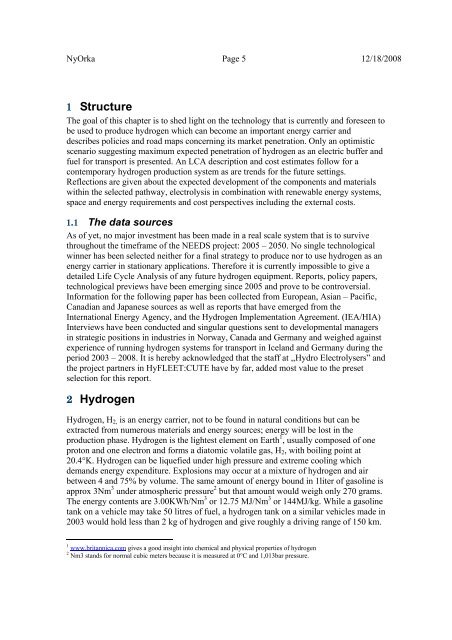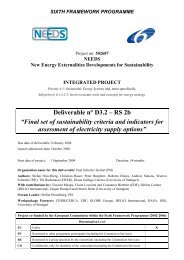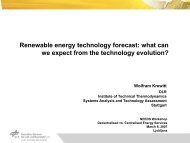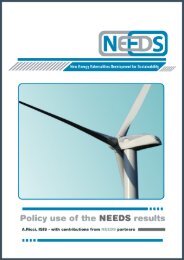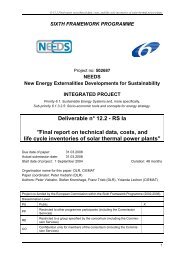Generation, of the energy carrier HYDROGEN In context ... - needs
Generation, of the energy carrier HYDROGEN In context ... - needs
Generation, of the energy carrier HYDROGEN In context ... - needs
You also want an ePaper? Increase the reach of your titles
YUMPU automatically turns print PDFs into web optimized ePapers that Google loves.
NyOrka Page 5 12/18/20081 StructureThe goal <strong>of</strong> this chapter is to shed light on <strong>the</strong> technology that is currently and foreseen tobe used to produce hydrogen which can become an important <strong>energy</strong> <strong>carrier</strong> anddescribes policies and road maps concerning its market penetration. Only an optimisticscenario suggesting maximum expected penetration <strong>of</strong> hydrogen as an electric buffer andfuel for transport is presented. An LCA description and cost estimates follow for acontemporary hydrogen production system as are trends for <strong>the</strong> future settings.Reflections are given about <strong>the</strong> expected development <strong>of</strong> <strong>the</strong> components and materialswithin <strong>the</strong> selected pathway, electrolysis in combination with renewable <strong>energy</strong> systems,space and <strong>energy</strong> requirements and cost perspectives including <strong>the</strong> external costs.1.1 The data sourcesAs <strong>of</strong> yet, no major investment has been made in a real scale system that is to survivethroughout <strong>the</strong> timeframe <strong>of</strong> <strong>the</strong> NEEDS project: 2005 – 2050. No single technologicalwinner has been selected nei<strong>the</strong>r for a final strategy to produce nor to use hydrogen as an<strong>energy</strong> <strong>carrier</strong> in stationary applications. Therefore it is currently impossible to give adetailed Life Cycle Analysis <strong>of</strong> any future hydrogen equipment. Reports, policy papers,technological previews have been emerging since 2005 and prove to be controversial.<strong>In</strong>formation for <strong>the</strong> following paper has been collected from European, Asian – Pacific,Canadian and Japanese sources as well as reports that have emerged from <strong>the</strong><strong>In</strong>ternational Energy Agency, and <strong>the</strong> Hydrogen Implementation Agreement. (IEA/HIA)<strong>In</strong>terviews have been conducted and singular questions sent to developmental managersin strategic positions in industries in Norway, Canada and Germany and weighed againstexperience <strong>of</strong> running hydrogen systems for transport in Iceland and Germany during <strong>the</strong>period 2003 – 2008. It is hereby acknowledged that <strong>the</strong> staff at ,,Hydro Electrolysers” and<strong>the</strong> project partners in HyFLEET:CUTE have by far, added most value to <strong>the</strong> presetselection for this report.2 HydrogenHydrogen, H 2, is an <strong>energy</strong> <strong>carrier</strong>, not to be found in natural conditions but can beextracted from numerous materials and <strong>energy</strong> sources; <strong>energy</strong> will be lost in <strong>the</strong>production phase. Hydrogen is <strong>the</strong> lightest element on Earth 1 , usually composed <strong>of</strong> oneproton and one electron and forms a diatomic volatile gas, H 2 , with boiling point at20.4°K. Hydrogen can be liquefied under high pressure and extreme cooling whichdemands <strong>energy</strong> expenditure. Explosions may occur at a mixture <strong>of</strong> hydrogen and airbetween 4 and 75% by volume. The same amount <strong>of</strong> <strong>energy</strong> bound in 1liter <strong>of</strong> gasoline isapprox 3Nm 3 under atmospheric pressure 2 but that amount would weigh only 270 grams.The <strong>energy</strong> contents are 3.00KWh/Nm 3 or 12.75 MJ/Nm 3 or 144MJ/kg. While a gasolinetank on a vehicle may take 50 litres <strong>of</strong> fuel, a hydrogen tank on a similar vehicles made in2003 would hold less than 2 kg <strong>of</strong> hydrogen and give roughly a driving range <strong>of</strong> 150 km.1 www.britannica.com gives a good insight into chemical and physical properties <strong>of</strong> hydrogen2 Nm3 stands for normal cubic meters because it is measured at 0°C and 1,013bar pressure.


